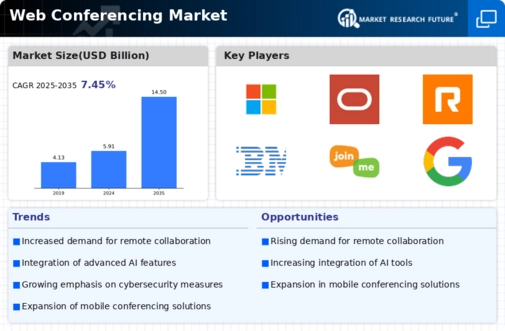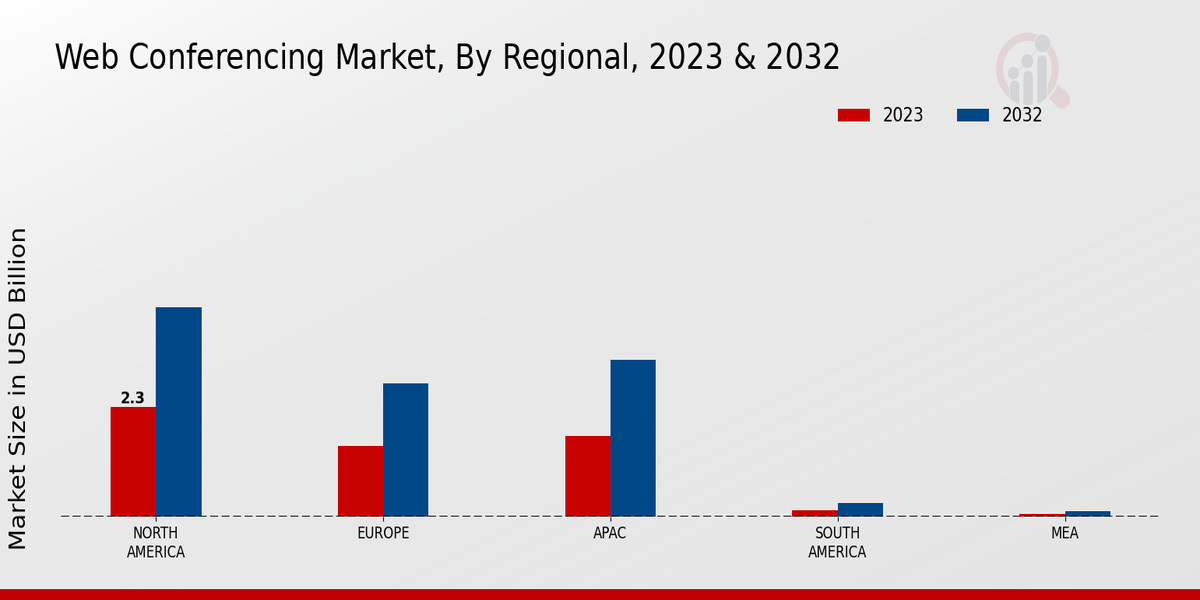Market Growth Projections
The Global Web Conferencing Market Industry is poised for substantial growth, with projections indicating a market size of 5.91 USD Billion in 2024 and an anticipated increase to 14.5 USD Billion by 2035. This growth trajectory suggests a compound annual growth rate of 8.53% from 2025 to 2035, reflecting the increasing reliance on web conferencing solutions across various sectors. The market's expansion is driven by factors such as technological advancements, rising demand for remote collaboration, and the growing adoption of these tools in education and business. These projections highlight the evolving landscape of communication technologies.
Increased Focus on Cost Efficiency
Cost efficiency remains a driving force within the Global Web Conferencing Market Industry. Organizations are increasingly recognizing the financial benefits of adopting web conferencing solutions over traditional in-person meetings. By minimizing travel expenses and optimizing time management, businesses can allocate resources more effectively. This shift towards virtual meetings is reflected in the projected compound annual growth rate of 8.53% from 2025 to 2035. As companies continue to prioritize budget-friendly solutions, the demand for web conferencing tools is likely to expand, further solidifying their role in modern business practices.
Growing Adoption in Education Sector
The education sector's growing adoption of web conferencing tools is a notable driver of the Global Web Conferencing Market Industry. Educational institutions are increasingly utilizing these platforms for remote learning, virtual classrooms, and collaborative projects. This shift not only enhances accessibility for students but also fosters a more interactive learning environment. As educational institutions continue to embrace digital transformation, the market is poised for growth, with projections indicating a rise to 5.91 USD Billion in 2024. The integration of web conferencing in education underscores its potential to revolutionize traditional learning methodologies.
Rising Demand for Remote Collaboration
The Global Web Conferencing Market Industry experiences a notable surge in demand for remote collaboration tools. As organizations increasingly adopt hybrid work models, the need for effective communication solutions becomes paramount. In 2024, the market is projected to reach 5.91 USD Billion, reflecting a growing reliance on web conferencing platforms to facilitate seamless interactions among geographically dispersed teams. This trend is further supported by advancements in technology, which enhance user experience and accessibility. Companies are investing in these tools to maintain productivity and foster collaboration, indicating a robust trajectory for the market.
Globalization and Cross-Border Collaboration
The ongoing trend of globalization significantly influences the Global Web Conferencing Market Industry. As businesses expand their operations across borders, the need for effective communication tools becomes increasingly critical. Web conferencing platforms facilitate real-time collaboration among teams located in different countries, breaking down geographical barriers. This trend is expected to contribute to the market's growth, with a projected increase to 14.5 USD Billion by 2035. The ability to connect diverse teams enhances innovation and productivity, making web conferencing an essential component of global business strategies.
Technological Advancements in Communication Tools
Technological innovations play a crucial role in shaping the Global Web Conferencing Market Industry. The integration of artificial intelligence, machine learning, and enhanced video quality significantly improves user engagement and satisfaction. These advancements enable features such as real-time language translation and automated transcription, which cater to diverse global audiences. As organizations seek to leverage these technologies, the market is expected to grow substantially, with projections indicating a rise to 14.5 USD Billion by 2035. This growth underscores the importance of staying at the forefront of technological developments to meet evolving user needs.











